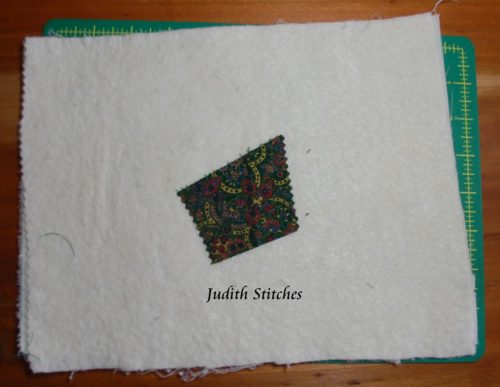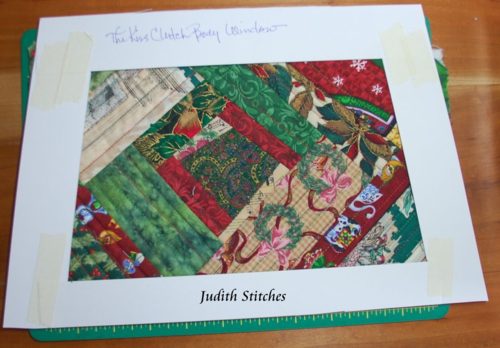The Kiss Clutch made with Quilt As You Go (QAYG) techniques
Sunday, 22 November 2015
During our recent KISS Clutch sew along in our Facebook Group, Judith showed an awesome KISS Clutch she made using QAYG techniques. Luckily for us, she has agreed to share the process with us, for those of you whom are new to quilting, like me! AWESOME! Over to you Judith:
——————————————————————————————————-
The Kiss Clutch by Chris W Designs made with Quilt As You Go (QAYG) techniques
by Judith Clauss of Judith Stitches
Recently, I participated in a delightful sew along to make the Kiss Clutch by ChrisW Designs on the ChrisW Designs Patterns Group on Facebook and decided to make mine using a Quilt as You Go (QAYG) technique. When people asked how I did my first one, I made a second one and wrote this short tutorial to show how I did it.
Here are the two Kiss Clutches I made.
Figure 1 – Front of first clutch

Figure 1
Figure 2 – Back of first clutch

Figure 2
Figure 3 – Front of first clutch with flap open

Figure 3
Figure 4 – Front of second clutch

Figure 4
Figure 5 – Back of second clutch

Figure 5
Figure 6 – Front of second clutch with flap open

Figure 6
Materials needed to create the fabric to be used for the exterior of the Kiss Clutch:
You will need your own Kiss Clutch pattern for directions on making the clutch. The pattern may be purchased and downloaded from Christine's Shop HERE.
- Thin cotton batting or fleece larger than your pattern pieces – about 9” x 12” (23cm x 30.5cm)
- Cotton backing fabric in the same size (I used some old sheeting as my backing because the lining covers it when the clutch is completed.)
- Pile of cotton scraps (other fabrics may be used, just make sure they can withstand pressing and won’t shrink). I chose to use Christmas fabrics that I had been saving, but you can use whatever scraps you have. You can use random scraps or organize by color families, or by light, medium and dark (as is often done in many quilt blocks). I often cut leftover fabric into strips and save for projects such as this one, but you can use mixed shape pieces. The main thing is to use up some scraps and have fun at the same time. I find sitting and piecing to be quite relaxing and soothing.
Let’s begin:
- Cut your batting or fleece and your backing fabric pieces. I cut 3, one for each of the main exterior pattern pieces.
- Layer the batting or fleece on the backing fabric to create the base to which you will stitch your scraps. Because I like mine to stay nice and flat, I use a tiny bit of temporary spray adhesive to hold each set together but you could also pin them together. I personally use 505 Spray because it won’t gum up my needles.
- Now you are ready to start adding your scraps, but first there are a couple of considerations. Look at my samples and decide whether you want to start with a square or rectangular shape first or with an irregular shape. If you look carefully you will see the differences. The first clutch was made by starting with a rectangular shaped scrap and the second clutch was made by starting with an irregularly shaped scrap. (As an aside, it is fun to try beginning with different shaped pieces and see what happens.) See the photos in Figures 7 and 8.

Figure 7

Figure 8
- Start with your batting or fleece on top and place your first fabric scrap right side up somewhere near the middle of your prepared piece. (I usually pick the one that I want to be the focal point either by color or the image on the fabric scrap). You really do not need to do anything to secure the fabric scrap, your stitching will quickly do that. The photo in Figure 9 shows how I placed the first piece for the second clutch.

Figure 9
- I tend to use a 2.5 stitch length for this piecing technique, but that is a personal preference. Now you will simply stitch straight lines parallel to each other back a forth to secure your first scrap to the base quilting it at the same time. Begin stitching two or three stitches before the edge of your fabric scrap and stitch straight across parallel to one of the sides until you are two to three stitches past the opposite edge. It is neater if you don’t cut your threads on each pass. Instead simply leave the needle down and lift the foot rotating until the foot is parallel to the edge of the fabric. Stitch 3-5 stitches and then rotate back towards the fabric and make your next line of stitching parallel to the first. You can make the parallel rows of stitching the same distance apart or you can vary them. When you have the first piece tacked down, it is time to add the second piece. See Figure 10.

Figure 10
- Place your second scrap right side down aligning the edge of one side of your first fabric scrap with an edge of the second fabric scrap. Make sure that your fabric scraps are the same length because you do not want to end up with gaps where the base is not completely covered with fabric. Stitch together with about a ¼ inch seam. (Hint: I like to use a nice flat foot that glides smoothly across the fuzzy batting or fleece so that it doesn’t snag.) See Figure 11.

Figure 11
- I begin a few stitches before and end a few stitches after each row of stitching just as described for the initial piece. The difference here will be that once you are several stitches past the end of your scrap, you will flip the second scrap so that the seam you just did is hidden and the scrap is right side up. You will now continue with your parallel quilting on the right side of your second scrap piece. Continue adding pieces working outward from your first scrap until you have completely covered your base. See Figures 12 and 13.

Figure 12

Figure 13
Do not be surprised or dismayed if your base is warped with the sides no longer even. All those quilting stitches push and pull the fabrics. That is normal. You can square the whole piece up or simply cut your pattern from the center section.
I created a window of each pattern piece by simply taping strips of card stock around the outside edge of the pattern piece. I can use the window to audition the piece and pick the section most pleasing to me. See Figure 14.

Figure 14
In my samples, I chose to vary my Christmas themed fabrics by light, medium and dark colors as I work around and outward from the center piece. See Figure 15. You can also vary by colors or patterns. Some people like high key pieces made of all light colored fabrics or low key made of all dark colored fabrics. Others like to use a variety of fabrics in one or two colors like all greens or using just browns and greens or blacks and whites. The choice is yours and there are really no wrong choices!

Figure 15
————————————————————————————————–
Thank you so much Judith! This is fantastic! 🙂 I am sure we are going to see a whole swag of new KISS Clutches made using this technique!
You can visit Judith's inspiring Blog HERE!
Get your KISS Clutch pattern HERE!
Happy QAYG'ing 🙂









|
Comments (4)
|
Comments
The Kiss Clutch made with Quilt As You Go (QAYG) techniques
During our recent KISS Clutch sew along in our Facebook Group, Judith showed an awesome KISS Clutch she made using QAYG techniques. Luckily for us, she has agreed to share the process with us, for those of you whom are new to quilting, like me! AWESOME! Over to you Judith:
——————————————————————————————————-
The Kiss Clutch by Chris W Designs made with Quilt As You Go (QAYG) techniques
by Judith Clauss of Judith Stitches
Recently, I participated in a delightful sew along to make the Kiss Clutch by ChrisW Designs on the ChrisW Designs Patterns Group on Facebook and decided to make mine using a Quilt as You Go (QAYG) technique. When people asked how I did my first one, I made a second one and wrote this short tutorial to show how I did it.
Here are the two Kiss Clutches I made.
Figure 1 – Front of first clutch

Figure 1
Figure 2 – Back of first clutch

Figure 2
Figure 3 – Front of first clutch with flap open

Figure 3
Figure 4 – Front of second clutch

Figure 4
Figure 5 – Back of second clutch

Figure 5
Figure 6 – Front of second clutch with flap open

Figure 6
Materials needed to create the fabric to be used for the exterior of the Kiss Clutch:
You will need your own Kiss Clutch pattern for directions on making the clutch. The pattern may be purchased and downloaded from Christine's Shop HERE.
- Thin cotton batting or fleece larger than your pattern pieces – about 9” x 12” (23cm x 30.5cm)
- Cotton backing fabric in the same size (I used some old sheeting as my backing because the lining covers it when the clutch is completed.)
- Pile of cotton scraps (other fabrics may be used, just make sure they can withstand pressing and won’t shrink). I chose to use Christmas fabrics that I had been saving, but you can use whatever scraps you have. You can use random scraps or organize by color families, or by light, medium and dark (as is often done in many quilt blocks). I often cut leftover fabric into strips and save for projects such as this one, but you can use mixed shape pieces. The main thing is to use up some scraps and have fun at the same time. I find sitting and piecing to be quite relaxing and soothing.
Let’s begin:
- Cut your batting or fleece and your backing fabric pieces. I cut 3, one for each of the main exterior pattern pieces.
- Layer the batting or fleece on the backing fabric to create the base to which you will stitch your scraps. Because I like mine to stay nice and flat, I use a tiny bit of temporary spray adhesive to hold each set together but you could also pin them together. I personally use 505 Spray because it won’t gum up my needles.
- Now you are ready to start adding your scraps, but first there are a couple of considerations. Look at my samples and decide whether you want to start with a square or rectangular shape first or with an irregular shape. If you look carefully you will see the differences. The first clutch was made by starting with a rectangular shaped scrap and the second clutch was made by starting with an irregularly shaped scrap. (As an aside, it is fun to try beginning with different shaped pieces and see what happens.) See the photos in Figures 7 and 8.

Figure 7

Figure 8
- Start with your batting or fleece on top and place your first fabric scrap right side up somewhere near the middle of your prepared piece. (I usually pick the one that I want to be the focal point either by color or the image on the fabric scrap). You really do not need to do anything to secure the fabric scrap, your stitching will quickly do that. The photo in Figure 9 shows how I placed the first piece for the second clutch.

Figure 9
- I tend to use a 2.5 stitch length for this piecing technique, but that is a personal preference. Now you will simply stitch straight lines parallel to each other back a forth to secure your first scrap to the base quilting it at the same time. Begin stitching two or three stitches before the edge of your fabric scrap and stitch straight across parallel to one of the sides until you are two to three stitches past the opposite edge. It is neater if you don’t cut your threads on each pass. Instead simply leave the needle down and lift the foot rotating until the foot is parallel to the edge of the fabric. Stitch 3-5 stitches and then rotate back towards the fabric and make your next line of stitching parallel to the first. You can make the parallel rows of stitching the same distance apart or you can vary them. When you have the first piece tacked down, it is time to add the second piece. See Figure 10.

Figure 10
- Place your second scrap right side down aligning the edge of one side of your first fabric scrap with an edge of the second fabric scrap. Make sure that your fabric scraps are the same length because you do not want to end up with gaps where the base is not completely covered with fabric. Stitch together with about a ¼ inch seam. (Hint: I like to use a nice flat foot that glides smoothly across the fuzzy batting or fleece so that it doesn’t snag.) See Figure 11.

Figure 11
- I begin a few stitches before and end a few stitches after each row of stitching just as described for the initial piece. The difference here will be that once you are several stitches past the end of your scrap, you will flip the second scrap so that the seam you just did is hidden and the scrap is right side up. You will now continue with your parallel quilting on the right side of your second scrap piece. Continue adding pieces working outward from your first scrap until you have completely covered your base. See Figures 12 and 13.

Figure 12

Figure 13
Do not be surprised or dismayed if your base is warped with the sides no longer even. All those quilting stitches push and pull the fabrics. That is normal. You can square the whole piece up or simply cut your pattern from the center section.
I created a window of each pattern piece by simply taping strips of card stock around the outside edge of the pattern piece. I can use the window to audition the piece and pick the section most pleasing to me. See Figure 14.

Figure 14
In my samples, I chose to vary my Christmas themed fabrics by light, medium and dark colors as I work around and outward from the center piece. See Figure 15. You can also vary by colors or patterns. Some people like high key pieces made of all light colored fabrics or low key made of all dark colored fabrics. Others like to use a variety of fabrics in one or two colors like all greens or using just browns and greens or blacks and whites. The choice is yours and there are really no wrong choices!

Figure 15
————————————————————————————————–
Thank you so much Judith! This is fantastic! 🙂 I am sure we are going to see a whole swag of new KISS Clutches made using this technique!
You can visit Judith's inspiring Blog HERE!
Get your KISS Clutch pattern HERE!
Happy QAYG'ing 🙂









View the entire comment thread.
Please enable JavaScript if you would like to comment on this blog.
Welcome!
- Don’t you just LOVE handbags? I know I do and I am TOTALLY addicted to making them! Imagine being able to make handbags and purses that are unique to YOU and exactly the style, colour, size and shape that YOU want them to be? ChrisW Designs range of designer bag patterns will help you to do just that! Nobody will believe you made them yourself!

Search









.sidebar-slider-sew_alongs .bx-viewport { border: 0 !important; background: transparent !important; }
.sidebar-slider-sew_alongs .bx-viewport img { margin: 0 !important; }
.sidebar-slider-sew_alongs .bx-controls { margin-top: -10px !important; }
.sidebar-slider-sew_alongs li:not(:first-of-type) { display: none; }
Sew Alongs
@chriswdesigns
.sidebar-slider-bag_making_tutorials .bx-viewport { border: 0 !important; background: transparent !important; }
.sidebar-slider-bag_making_tutorials .bx-viewport img { margin: 0 !important; }
.sidebar-slider-bag_making_tutorials .bx-controls { margin-top: -10px !important; }
.sidebar-slider-bag_making_tutorials li:not(:first-of-type) { display: none; }
Tutorials
.sidebar-slider-guest_posts .bx-viewport { border: 0 !important; background: transparent !important; }
.sidebar-slider-guest_posts .bx-viewport img { margin: 0 !important; }
.sidebar-slider-guest_posts .bx-controls { margin-top: -10px !important; }
.sidebar-slider-guest_posts li:not(:first-of-type) { display: none; }
Popular Posts
Categories
- Bag Making Resources
- Bag Making Tips
- Bag Making Tutorials
- Bag Naming Competitions!
- Bag Photos
- Blank Slate Sketches
- Blog Hops
- ChrisW Designs Bag Sewing Video Tutorials
- ChrisW Designs Patterns
- Competitions
- Easy Street Patterns
- Featured
- Free Patterns
- Fundamentals
- Giveaways!
- Guest Posts
- In the Press
- Inspirational Bags
- Minimise to Maximise
- My Ramblings
- My Studio
- NEW Patterns
- News
- Pattern Hacks
- Pattern Info!
- Ready Made Bags
- Revised Patterns
- Sales!
- Sew Alongs
- Sewing Machine Reviews
- Sewing Spaces
- Sewist Interviews
- Sponsored Posts
- Strap Series
- The Art of Bag Making
- Tools of the Trade!
- Website ChitChat
- Zipper 101
Visit Christine Welsh’s profile on Pinterest.
Junyuan Bags | Professional Bag Manufacturer
Ten articles before and after
Reducing the Stow It All Tote by 15% – By Karen Wetherall
Sewing With Cork – by Toni of The Little British Fabric Shop – ChrisW Designs
Creating Fabric Using Color Weaving – With Dianna Leckner!
How to Sew a Fabric Tab End on a Zipper!
Stand Alone ID Window Tutorial





































 Mobile/What's App/Wechat
Mobile/What's App/Wechat E-Mail
E-Mail ADD
ADD




